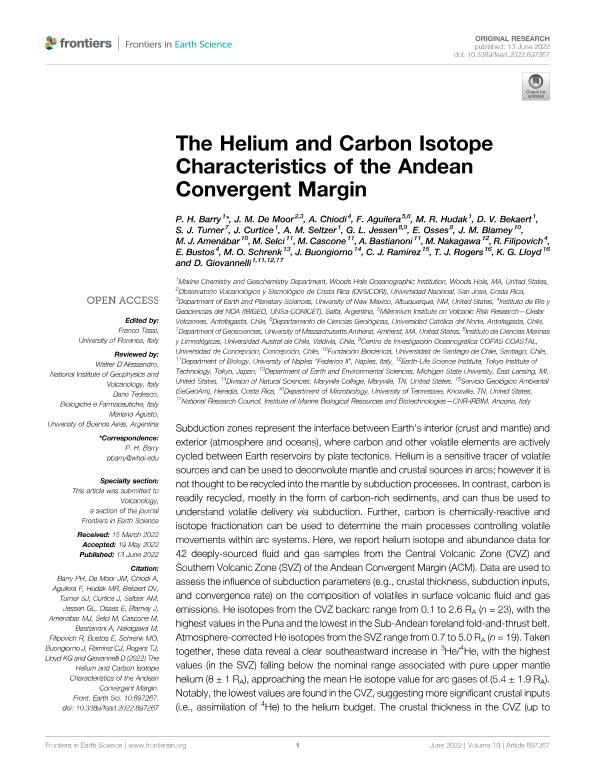Artículo
The Helium and Carbon Isotope Characteristics of the Andean Convergent Margin
Barry, P. H.; De Moor, J. M.; Chiodi, Agostina Laura ; Aguilera, F.; Hudak, M. R.; Bekaert, D. V.; Turner, S. J.; Curtice, J.; Seltzer, A. M.; Jessen, G. L.; Osses, E.; Blamey, J. M.; Amenábar, M. J.; Selci, M.; Cascone, M.; Bastianoni, A.; Nakagawa, M.; Filipovich, Ruben Eduardo
; Aguilera, F.; Hudak, M. R.; Bekaert, D. V.; Turner, S. J.; Curtice, J.; Seltzer, A. M.; Jessen, G. L.; Osses, E.; Blamey, J. M.; Amenábar, M. J.; Selci, M.; Cascone, M.; Bastianoni, A.; Nakagawa, M.; Filipovich, Ruben Eduardo ; Bustos, Emilce
; Bustos, Emilce ; Schrenk, M. O.; Buongiorno, J.; Ramírez, C. J.; Rogers, T. J.; Lloyd, K. G.; Giovannelli, D.
; Schrenk, M. O.; Buongiorno, J.; Ramírez, C. J.; Rogers, T. J.; Lloyd, K. G.; Giovannelli, D.
 ; Aguilera, F.; Hudak, M. R.; Bekaert, D. V.; Turner, S. J.; Curtice, J.; Seltzer, A. M.; Jessen, G. L.; Osses, E.; Blamey, J. M.; Amenábar, M. J.; Selci, M.; Cascone, M.; Bastianoni, A.; Nakagawa, M.; Filipovich, Ruben Eduardo
; Aguilera, F.; Hudak, M. R.; Bekaert, D. V.; Turner, S. J.; Curtice, J.; Seltzer, A. M.; Jessen, G. L.; Osses, E.; Blamey, J. M.; Amenábar, M. J.; Selci, M.; Cascone, M.; Bastianoni, A.; Nakagawa, M.; Filipovich, Ruben Eduardo ; Bustos, Emilce
; Bustos, Emilce ; Schrenk, M. O.; Buongiorno, J.; Ramírez, C. J.; Rogers, T. J.; Lloyd, K. G.; Giovannelli, D.
; Schrenk, M. O.; Buongiorno, J.; Ramírez, C. J.; Rogers, T. J.; Lloyd, K. G.; Giovannelli, D.
Fecha de publicación:
05/2022
Editorial:
Frontiers Media
Revista:
Frontiers in Earth Science
ISSN:
2296-6463
Idioma:
Inglés
Tipo de recurso:
Artículo publicado
Clasificación temática:
Resumen
Subduction zones represent the interface between Earth’s interior (crust and mantle) and exterior (atmosphere and oceans), where carbon and other volatile elements are actively cycled between Earth reservoirs by plate tectonics. Helium is a sensitive tracer of volatile sources and can be used to deconvolute mantle and crustal sources in arcs; however it is not thought to be recycled into the mantle by subduction processes. In contrast, carbon is readily recycled, mostly in the form of carbon-rich sediments, and can thus be used to understand volatile delivery via subduction. Further, carbon is chemically-reactive and isotope fractionation can be used to determine the main processes controlling volatile movements within arc systems. Here, we report helium isotope and abundance data for 42 deeply-sourced fluid and gas samples from the Central Volcanic Zone (CVZ) and Southern Volcanic Zone (SVZ) of the Andean Convergent Margin (ACM). Data are used to assess the influence of subduction parameters (e.g., crustal thickness, subduction inputs, and convergence rate) on the composition of volatiles in surface volcanic fluid and gas emissions. He isotopes from the CVZ backarc range from 0.1 to 2.6 RA (n = 23), with the highest values in the Puna and the lowest in the Sub-Andean foreland fold-and-thrust belt. Atmosphere-corrected He isotopes from the SVZ range from 0.7 to 5.0 RA (n = 19). Taken together, these data reveal a clear southeastward increase in 3He/4He, with the highest values (in the SVZ) falling below the nominal range associated with pure upper mantle helium (8 ± 1 RA), approaching the mean He isotope value for arc gases of (5.4 ± 1.9 RA). Notably, the lowest values are found in the CVZ, suggesting more significant crustal inputs (i.e., assimilation of 4He) to the helium budget. The crustal thickness in the CVZ (up to 70 km) is significantly larger than in the SVZ, where it is just ∼40 km. We suggest that crustal thickness exerts a primary control on the extent of fluid-crust interaction, as helium and other volatiles rise through the upper plate in the ACM. We also report carbon isotopes from (n = 11) sites in the CVZ, where δ13C varies between −15.3‰ and −1.2‰ [vs. Vienna Pee Dee Belemnite (VPDB)] and CO2/3He values that vary by over two orders of magnitude (6.9 × 108–1.7 × 1011). In the SVZ, carbon isotope ratios are also reported from (n = 13) sites and vary between −17.2‰ and −4.1‰. CO2/3He values vary by over four orders of magnitude (4.7 × 107–1.7 × 1012). Low δ13C and CO2/3He values are consistent with CO2 removal (e.g., calcite precipitation and gas dissolution) in shallow hydrothermal systems. Carbon isotope fractionation modeling suggests that calcite precipitation occurs at temperatures coincident with the upper temperature limit for life (122°C), suggesting that biology may play a role in C-He systematics of arc-related volcanic fluid and gas emissions.
Palabras clave:
ANDES (ARGENTINA AND CHILE)
,
CARBON
,
CVZ
,
HELIUM
,
SVZ
Archivos asociados
Licencia
Identificadores
Colecciones
Articulos(IBIGEO)
Articulos de INST.DE BIO Y GEOCIENCIAS DEL NOA
Articulos de INST.DE BIO Y GEOCIENCIAS DEL NOA
Citación
Barry, P. H.; De Moor, J. M.; Chiodi, Agostina Laura; Aguilera, F.; Hudak, M. R.; et al.; The Helium and Carbon Isotope Characteristics of the Andean Convergent Margin; Frontiers Media; Frontiers in Earth Science; 10; 5-2022; 1-20
Compartir
Altmétricas



